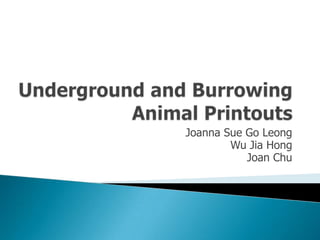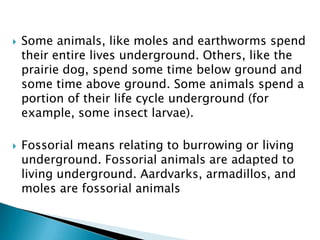burrowing animal printouts
- 1. Joanna Sue Go Leong Wu Jia Hong Joan Chu
- 2. ’üĮ Some animals live underground for all or much of the time. Living underground has many advantages, including protection from some predators, from extreme temperatures (both hot and cold), and from overly dry climates. Many animals also hunt for food underground, like tubers, roots, other plant material, worms, grubs, insects, insect eggs and larvae.
- 3. ’üĮ Some animals, like moles and earthworms spend their entire lives underground. Others, like the prairie dog, spend some time below ground and some time above ground. Some animals spend a portion of their life cycle underground (for example, some insect larvae). ’üĮ Fossorial means relating to burrowing or living underground. Fossorial animals are adapted to living underground. Aardvarks, armadillos, and moles are fossorial animals
- 4. AARDVARKS are large ARMADILLO is a small, mammals that eat burrowing, armored ants. mammal.
- 5. ’üĮ BILBY NAKED MOLE-RAT ’üĮ is a small marsupial with Small, almost hairless rodents wh long ears live in underground colonies in Africa
- 6. ’üĮ DESERT TORTOISE PUPFISH A tortoise from A small fish from desert waters of southwestern North America. This southwestern North fish burrows into mud and America. It spends most becomes dormant during cold of its life underground. weather.
- 7. ’üĮ TARANTULA MOLE A tarantula is a large, Moles are almost- hairy spider. Some blind, burrowing mammals. tarantulas live in underground burrows.
- 8. ’üĮ CHIPMUNKS ARE rodents that live in North America and Asia. Many chipmunks dig extensive networks of burrows
- 9. ’üĮ SAND DOLLARS are echinoderms, disk-shaped ’üĮ spiny-skinned sea bed animals that have 5-part radial symmetry. They partly bury themselves under the sand, with an edge poking up out of the sand









